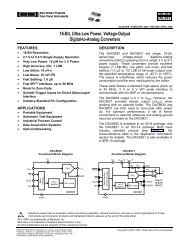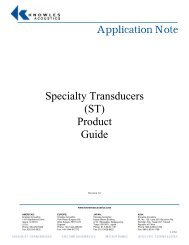AD7714* 3 V/5 V, CMOS, 500 µA Signal Conditioning ADC - dreamm
AD7714* 3 V/5 V, CMOS, 500 µA Signal Conditioning ADC - dreamm
AD7714* 3 V/5 V, CMOS, 500 µA Signal Conditioning ADC - dreamm
You also want an ePaper? Increase the reach of your titles
YUMPU automatically turns print PDFs into web optimized ePapers that Google loves.
AD7714<br />
AD7714-5 OUTPUT NOISE<br />
Table Ia shows the output rms noise and effective resolution for some typical notch and –3 dB frequencies for the AD7714-5 with<br />
f CLK IN = 2.4576 MHz while Table Ib gives the information for f CLK IN = 1 MHz. The numbers given are for the bipolar input ranges<br />
with a V REF of +2.5 V and with BUFFER = 0. These numbers are typical and are generated at an analog input voltage of 0 V. The<br />
numbers in brackets in each table are for the effective resolution of the part (rounded to the nearest 0.5 LSB). The effective resolution<br />
of the device is defined as the ratio of the output rms noise to the input full scale (i.e., 2 × V REF /GAIN). It should be noted that<br />
it is not calculated using peak-to-peak output noise numbers. Peak-to-peak noise numbers can be up to 6.6 times the rms numbers<br />
while effective resolution numbers based on peak-to-peak noise can be 2.5 bits below the effective resolution based on rms noise as<br />
quoted in the tables.<br />
The output noise from the part comes from two sources. The first is the electrical noise in the semiconductor devices used in the<br />
implementation of the modulator (device noise). Secondly, when the analog input signal is converted into the digital domain, quantization<br />
noise is added. The device noise is at a low level and is largely independent of frequency. The quantization noise starts at<br />
an even lower level but rises rapidly with increasing frequency to become the dominant noise source. Consequently, lower filter<br />
notch settings (below 100 Hz approximately for f CLK IN = 2.4576 MHz and below 40 Hz approximately for f CLK IN = 1 MHz) tend to<br />
be device noise dominated while higher notch settings are dominated by quantization noise. Changing the filter notch and cutoff<br />
frequency in the quantization-noise dominated region results in a more dramatic improvement in noise performance than it does in<br />
the device-noise dominated region as shown in Table I. Furthermore, quantization noise is added after the PGA, so effective resolution<br />
is largely independent of gain for the higher filter notch frequencies. Meanwhile, device noise is added in the PGA and, therefore,<br />
effective resolution reduces at high gains for lower notch frequencies. Additionally, in the device-noise dominated region, the<br />
output noise (in µV) is largely independent of reference voltage while in the quantization-noise dominated region, the noise is proportional<br />
to the value of the reference. It is possible to do post-filtering on the device to improve the output data rate for a given<br />
–3 dB frequency and also to further reduce the output noise.<br />
At the lower filter notch settings (below 60 Hz for f CLK IN = 2.4576 MHz and below 25 Hz for f CLK IN = 1 MHz), the no missing<br />
codes performance of the device is at the 24-bit level. At the higher settings, more codes will be missed until at 1 kHz notch setting<br />
for f CLK IN = 2.4576 MHz (400 Hz for f CLK IN = 1 MHz), no missing codes performance is only guaranteed to the 12-bit level.<br />
2<br />
Table Ia. AD7714-5 Output Noise/Resolution vs. Gain and First Notch for f CLK IN = 2.4576 MHz, BUFFER = 0<br />
Filter First<br />
Typical Output RMS Noise in µV (Effective Resolution in Bits)<br />
Notch & O/P –3 dB Gain of Gain of Gain of Gain of Gain of Gain of Gain of Gain of<br />
Data Rate Frequency 1 2 4 8 16 32 64 128<br />
5 Hz 1.31 Hz 0.87 (22.5) 0.48 (22.5) 0.24 (22.5) 0.2 (21.5) 0.18 (20.5) 0.17 (20) 0.17 (19) 0.17 (18)<br />
10 Hz 2.62 Hz 1.0 (22.5) 0.78 (21.5) 0.48 (21.5) 0.33 (21) 0.25 (20.5) 0.25 (19.5) 0.25 (18.5) 0.25 (17.5)<br />
25 Hz 6.55 Hz 1.8 (21.5) 1.1 (21) 0.63 (21) 0.5 (20) 0.44 (19.5) 0.41 (18.5) 0.38 (17.5) 0.38 (16.5)<br />
30 Hz 7.86 Hz 2.5 (21) 1.31 (21) 0.84 (20.5) 0.57 (20) 0.46 (19.5) 0.43 (18.5) 0.4 (17.5) 0.4 (16.5)<br />
50 Hz 13.1 Hz 4.33 (20) 2.06 (20) 1.2 (20) 0.64 (20) 0.54 (19) 0.46 (18.5) 0.46 (17.5) 0.46 (16.5)<br />
60 Hz 15.72 Hz 5.28 (20) 2.36 (20) 1.33 (20) 0.87 (19.5) 0.63 (19) 0.62 (18) 0.6 (17) 0.56 (16)<br />
100 Hz 26.2 Hz 12.1 (18.5) 5.9 (18.5) 2.86 (19) 1.91 (18.5) 1.06 (18) 0.83 (17.5) 0.82 (16.5) 0.76 (15.5)<br />
250 Hz 65.5 Hz 127 (15.5) 58 (15.5) 29 (15.5) 15.9 (15.5) 6.7 (15.5) 3.72 (15.5) 1.96 (15.5) 1.5 (14.5)<br />
<strong>500</strong> Hz 131 Hz 533 (13) 267 (13) 137 (13) 66 (13) 38 (13) 20 (13) 8.6 (13) 4.4 (13)<br />
1 kHz 262 Hz 2,850 (11) 1,258 (11) 680 (11) 297 (11) 131 (11) 99 (10.5) 53 (10.5) 28 (10.5)<br />
Table Ib. AD7714-5 Output Noise/Resolution vs. Gain and First Notch for f CLK IN = 1 MHz, BUFFER = 0<br />
Filter First<br />
Typical Output RMS Noise in µV (Effective Resolution in Bits)<br />
Notch & O/P –3 dB Gain of Gain of Gain of Gain of Gain of Gain of Gain of Gain of<br />
Data Rate Frequency 1 2 4 8 16 32 64 128<br />
2 Hz 0.52 Hz 0.75 (22.5) 0.56 (22) 0.31 (22) 0.19 (21.5) 0.17 (21) 0.14 (20) 0.14 (19) 0.14 (18)<br />
4 Hz 1.05 Hz 1.04 (22) 0.88 (21.5) 0.45 (21.5) 0.28 (21) 0.21 (20.5) 0.21 (19.5) 0.21 (18.5) 0.21 (17.5)<br />
10 Hz 2.62 Hz 1.66 (21.5) 1.01 (21.5) 0.77 (20.5) 0.41 (20.5) 0.37 (19.5) 0.35 (19) 0.35 (18) 0.35 (17)<br />
25 Hz 6.55 Hz 5.2 (20) 2.06 (20) 1.4 (20) 0.86 (19.5) 0.63 (19) 0.61 (18) 0.59 (17) 0.59 (16)<br />
30 Hz 7.86 Hz 7.1 (19.5) 3.28 (19.5) 1.42 (19.5) 1.07 (19) 0.78 (18.5) 0.64 (18) 0.61 (17) 0.61 (16)<br />
50 Hz 13.1 Hz 19.4 (18) 9.11 (18) 4.2 (18) 2.45 (18) 1.56 (17.5) 1.1 (17) 0.82 (16.5) 0.8 (15.5)<br />
60 Hz 15.72 Hz 25 (17.5) 16 (17.5) 6.5 (17.5) 2.9 (17.5) 1.93 (17.5) 1.4 (17) 1.1 (16) 0.98 (15.5)<br />
100 Hz 26.2 Hz 102 (15.5) 58 (15.5) 25 (15.5) 13.5 (15.5) 5.7 (15.5) 3.9 (15.5) 2.1 (15) 1.3 (15)<br />
200 Hz 52.4 Hz 637 (13) 259 (13) 130 (13) 76 (13) 33 (13) 16 (13) 11 (13) 6 (12.5)<br />
400 Hz 104.8 Hz 2,830 (11) 1,430 (11) 720 (11) 334 (11) 220 (10.5) 94 (10.5) 54 (10.5) 25 (10.5)<br />
REV. B –9–















